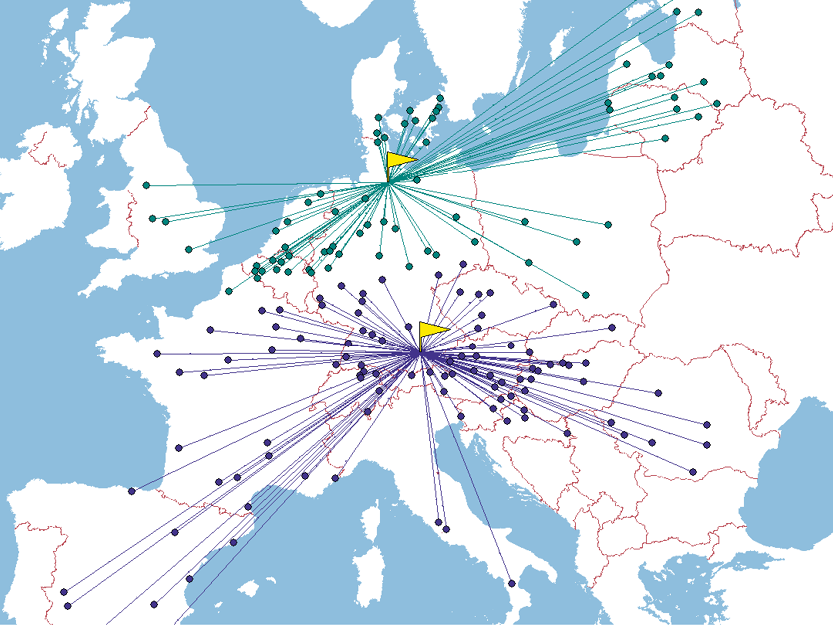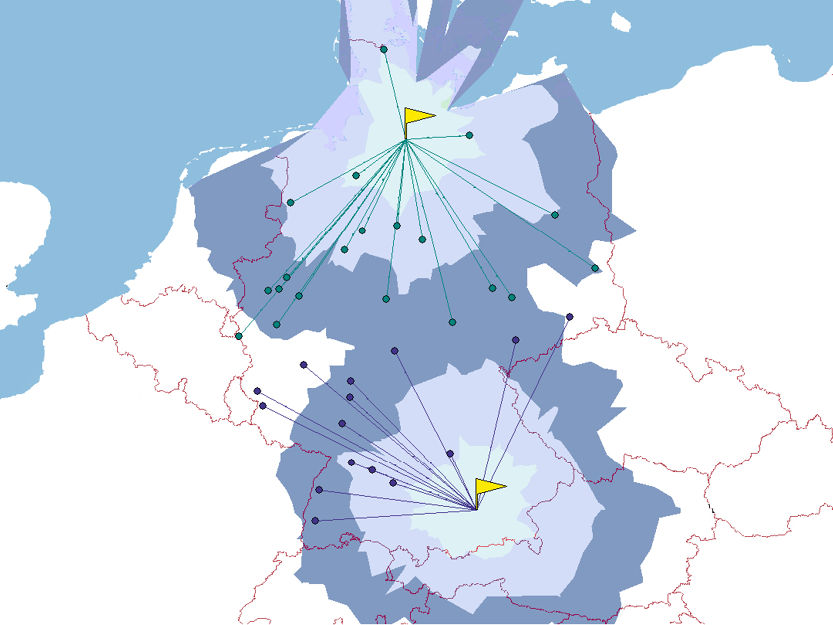The 10 most important questions
Which location is the best for the new distribution centre? From where can customers be supplied most quickly? Does a distribution structure with a central warehouse or with several regional warehouses suit the business better? Many companies ask themselves these and similar questions. How to develop a suitable distribution strategy and which questions are of central importance for this are described below.
1. The delivery service is to be improved – which distribution strategy is optimal?
Next-day delivery, same-day delivery, instant delivery – the demands on delivery services are constantly increasing. Keeping up with the delivery standard of one‘s own industry is a must; exceeding it can be an important competitive advantage. These developments sometimes require massive adjustments in the distribution strategy. There are many small measures that can help to shorten delivery times. However, significant improvements are usually achieved through more decentralised structures and the choice of location.


2. New warehouse construction or optimisation – which location is the right one?
If an additional distribution centre has to be set up to supply a new market, or if extensive maintenance and upgrading of buildings and logistics technology is necessary, companies are often faced with the question: Are these investments well spent? Or would it be better to invest in a new branch? Where should this be optimally located?
In addition to a fundamental analysis of the distribution strategy, companies should especially consider the time period for which the distribution structure should be designed, whether the strategy also has potential beyond that and whether a possible construction project is economical.
3. The regional warehouses cause high costs – does a centralisation make sense?
The right degree of centralisation in logistics is a highly individual matter. For a long time, strong centralisation was the trend because it reduced inventory and handling costs. Increasing demands on delivery service, high traffic densities and a lack of development prospects for existing locations are now bringing regional warehouses more into the conversation.
However, centralisation can still be worthwhile, for example in the case of
- rather moderate demands on delivery speed (e.g. next-day delivery in neighbouring regions),
- very large assortments with high inventory values,
- high demands on order cohesion (complete delivery from a central warehouse),
- a highly decentralised distribution structure with many small warehouse locations but high potential for improvement.
4. Definition of task and project goals – what is important?
Di erent scenarios are compared to determine the appropriate distribution strategy. In particular, the number of warehouse sites, their location, function and delivery routes can be varied. Based on these factors, countless alternatives can be developed. For a targeted analysis, the most plausible options should be defined and compared. This requires detailed knowledge of the initial situation, including the client‘s expectations and competitive situation, as well as a sure instinct for what is practically feasible and sensible.
5. How to assess the current situation correctly?
Dealing with the initial situation forms the indispensable basis for determining the logistics strategy. Based on the analysis of logistical key data, personnel deployment, running costs, the actual delivery service, the discussion of strengths, weaknesses and goals as well as preliminary considerations on the developability of locations and other aspects, the target strategy is developed and its advantages are tested on the basis of comprehensible criteria.
6. Are there other important factors influencing distribution strategy and location search?
Besides the analysis of logistics data and costs, there are other aspects, that are also relevant for the location determination. These include, for example:
- Property: Availability, price level, etc.
- Personnel: Availability, costs and skill level
- Environment: Development of regions and countries
- Risk minimisation: Redundancy in case of failures, simplified commissioning scenarios
7. Is the simulation of distribution strategies necessary?
The support of software for the analysis and development of distribution strategies is often helpful. Extensive calculations, e.g. in the transport-side assessment of location alternatives or the delineation of delivery areas, can often be significantly simplified with the help of simulation tools. Software can also provide good support in the visualisation of strategies.
However, not all factors relevant for distribution can be calculated or displayed by software. In particular, such software cannot take over a comprehensive assessment of the calculation results and entrepreneurial decisions from humans.

8. Is warehouse planning also useful as part of a distribution analysis?
In addition to a possible increase or decrease in inventory, the development of the warehouses is decisive for the necessary investments to implement a distribution strategy. Furthermore, the „handling costs“ resulting from inventory management are one of the three cost types relevant for comparison when assessing a distribution scenario, along with the running costs from inventory and transport. In order to be able to make reliable statements about investments and running costs, warehouse planning is therefore generally required as a basis.
9. Outsourcing or insourcing?
Companies also need to develop operator concepts for their warehouse locations as part of a distribution analysis. Options include:
- Outsourcing or insourcing,
- rental real estate or ownership.
The desire for flexibility in delivery service, direct influence on delivery quality and close customer contact are often arguments in favour of in-house management. A key argument in favour of outsourcing to a logistics service provider or renting a logistics property, on the other hand, is the possibility of keeping costs and investments for opening up a new market lower.
10. European distribution strategy – what to consider?
When developing a pan-European distribution strategy, some additional aspects should be taken into account:
- Delivery service: Customer expectations and the performance of logistics networks vary considerably from country to country.
- Personnel: Foreign languages, different legal frameworks and work cultures can make opening logistics locations abroad unattractive. Lower wage levels and high staff availability, on the other hand, may be arguments in favour of such a move.
- Security: The political and economic situation of a country should be taken into account in order to obtain investment security.
Conclusion: Distribution is moving into focus
Particularly due to the increasing demands on the delivery service, distribution is moving into focus. It is to be expected that this trend will continue, since the coordination of the distribution structure to individual customer groups is becoming more and more relevant. In order to be able to develop sustainable distribution strategies, all influencing factors should be considered comprehensively and the relevant aspects should be analysed in detail. This ensures that changes, which are often of great strategic and investment significance, are safeguarded in terms of content and budget.


